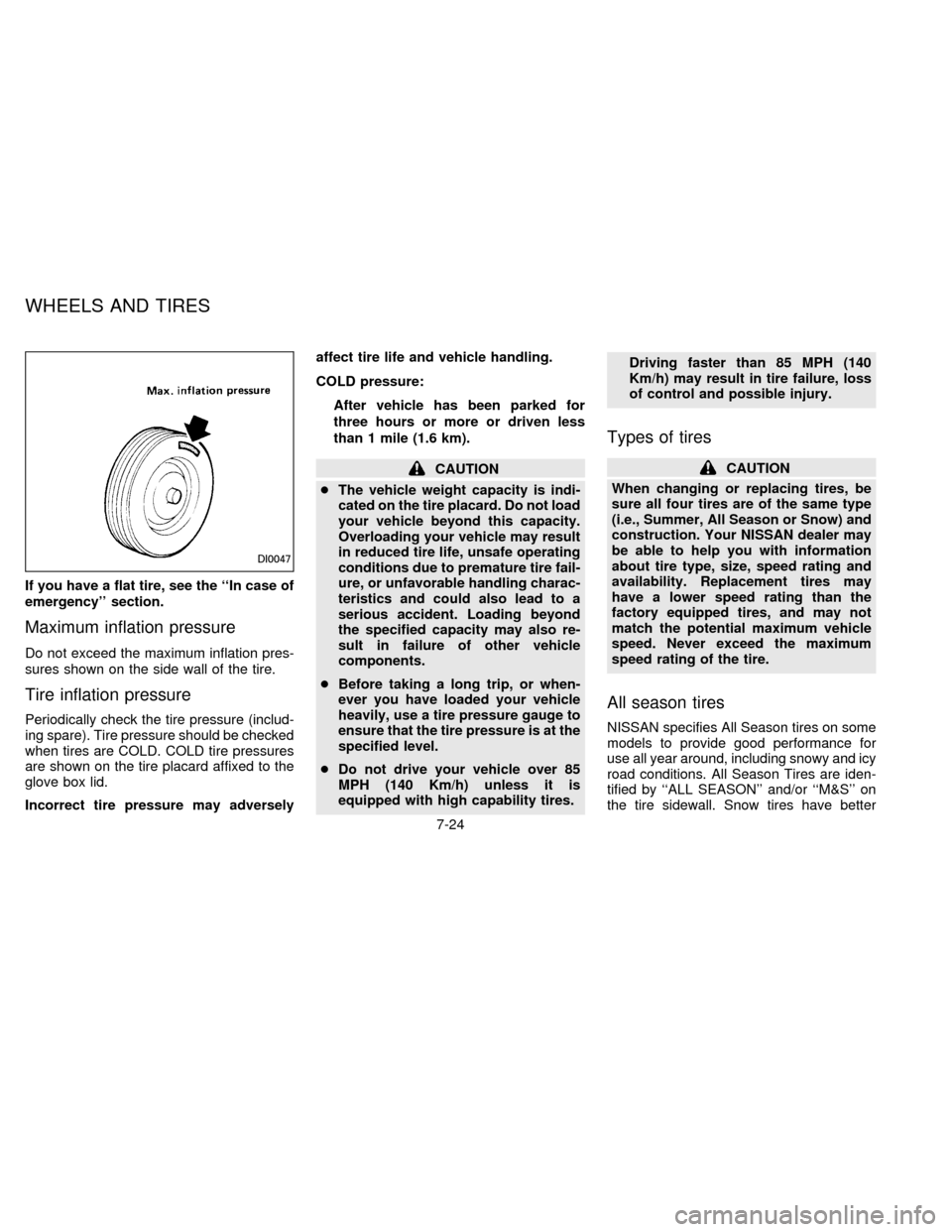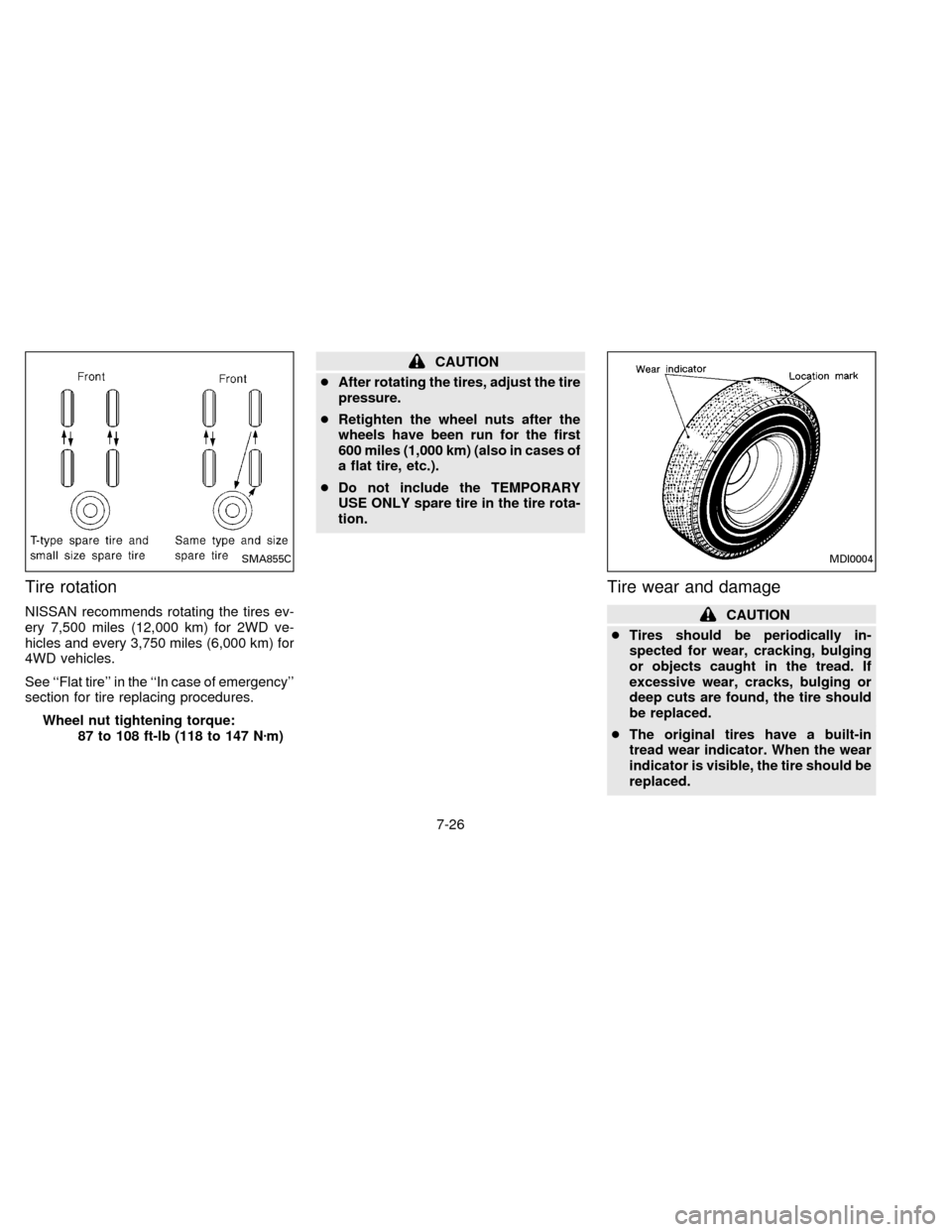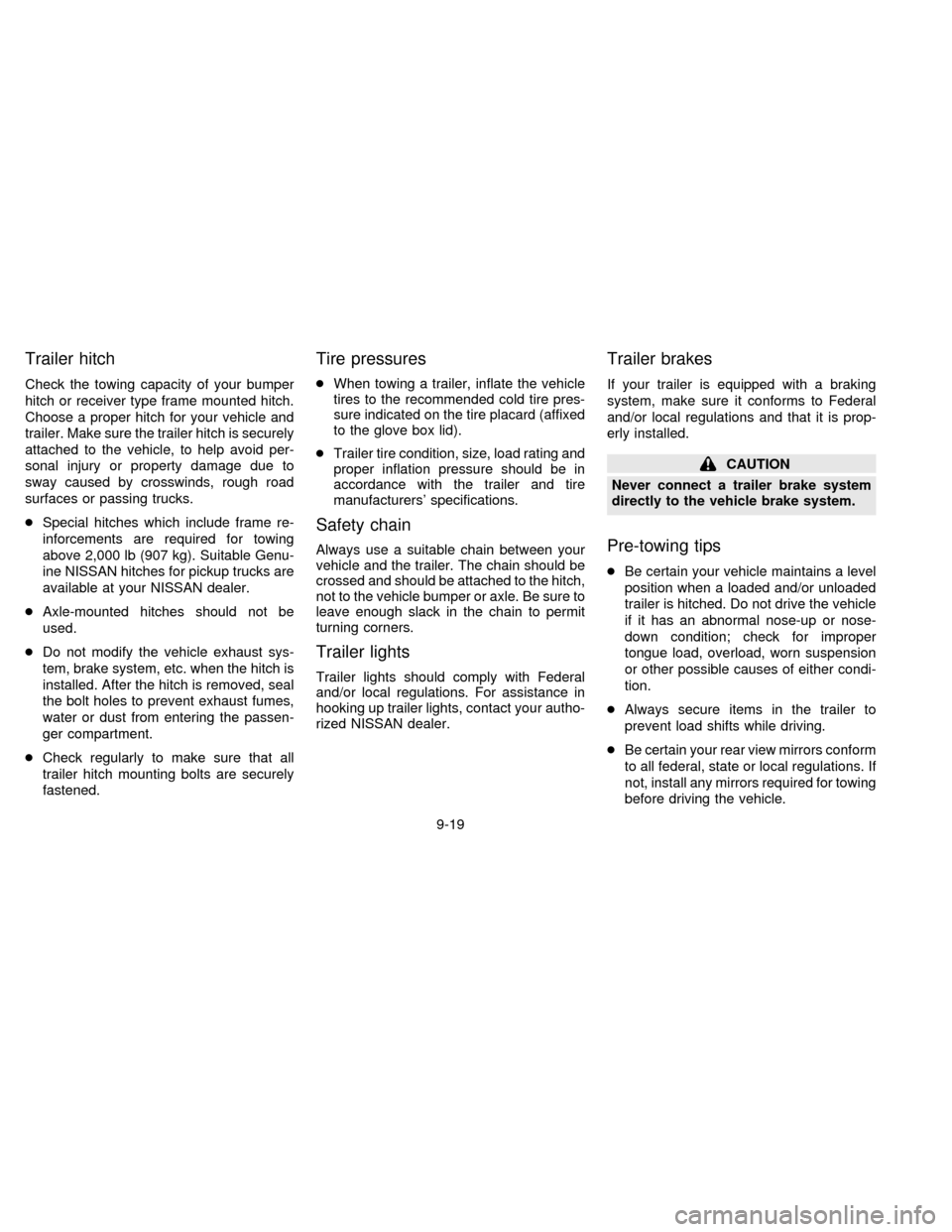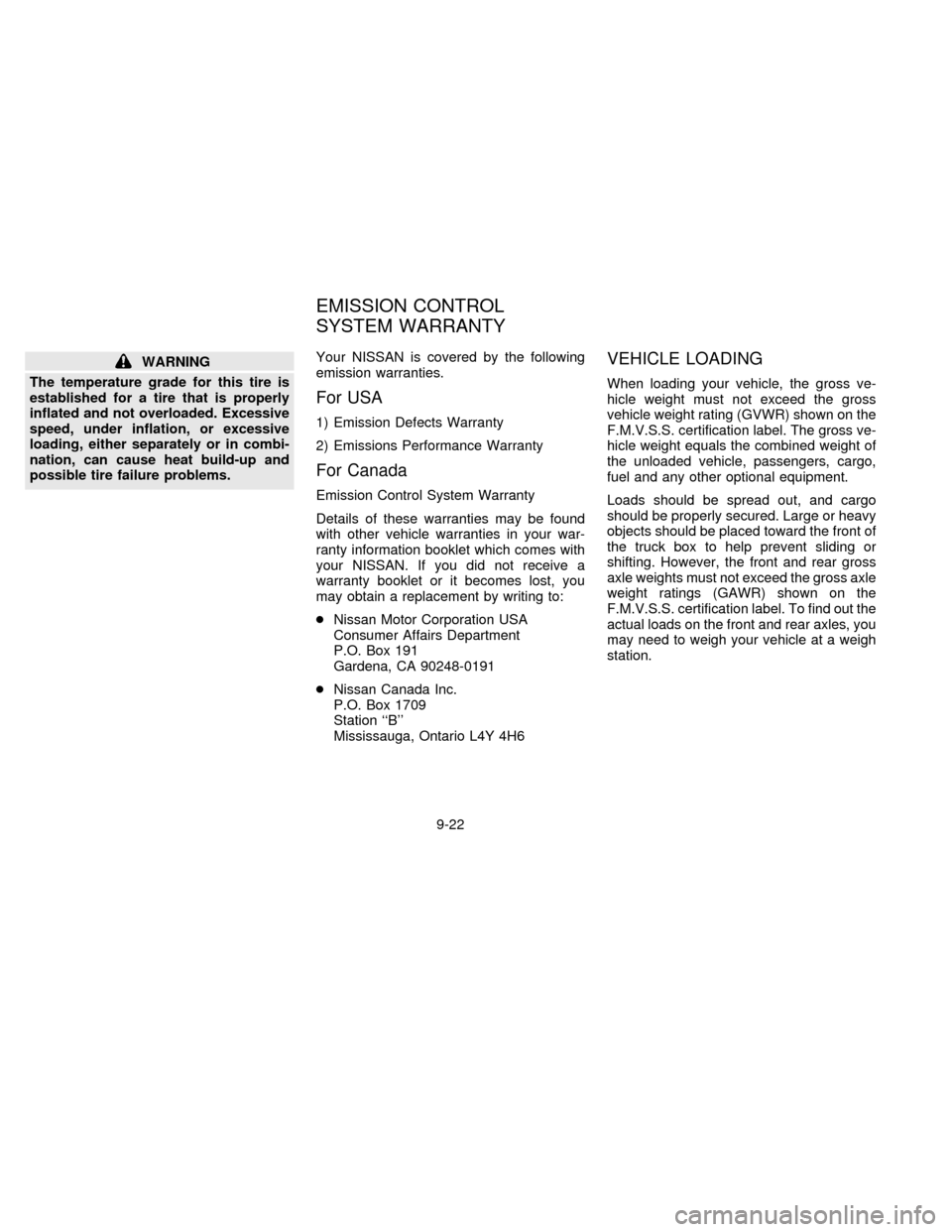1996 NISSAN FRONTIER flat tire
[x] Cancel search: flat tirePage 147 of 198

If you have a flat tire, see the ``In case of
emergency'' section.
Maximum inflation pressure
Do not exceed the maximum inflation pres-
sures shown on the side wall of the tire.
Tire inflation pressure
Periodically check the tire pressure (includ-
ing spare). Tire pressure should be checked
when tires are COLD. COLD tire pressures
are shown on the tire placard affixed to the
glove box lid.
Incorrect tire pressure may adverselyaffect tire life and vehicle handling.
COLD pressure:
After vehicle has been parked for
three hours or more or driven less
than 1 mile (1.6 km).
CAUTION
cThe vehicle weight capacity is indi-
cated on the tire placard. Do not load
your vehicle beyond this capacity.
Overloading your vehicle may result
in reduced tire life, unsafe operating
conditions due to premature tire fail-
ure, or unfavorable handling charac-
teristics and could also lead to a
serious accident. Loading beyond
the specified capacity may also re-
sult in failure of other vehicle
components.
cBefore taking a long trip, or when-
ever you have loaded your vehicle
heavily, use a tire pressure gauge to
ensure that the tire pressure is at the
specified level.
cDo not drive your vehicle over 85
MPH (140 Km/h) unless it is
equipped with high capability tires.Driving faster than 85 MPH (140
Km/h) may result in tire failure, loss
of control and possible injury.
Types of tires
CAUTION
When changing or replacing tires, be
sure all four tires are of the same type
(i.e., Summer, All Season or Snow) and
construction. Your NISSAN dealer may
be able to help you with information
about tire type, size, speed rating and
availability. Replacement tires may
have a lower speed rating than the
factory equipped tires, and may not
match the potential maximum vehicle
speed. Never exceed the maximum
speed rating of the tire.
All season tires
NISSAN specifies All Season tires on some
models to provide good performance for
use all year around, including snowy and icy
road conditions. All Season Tires are iden-
tified by ``ALL SEASON'' and/or ``M&S'' on
the tire sidewall. Snow tires have better
DI0047
WHEELS AND TIRES
7-24
ZX
Page 149 of 198

Tire rotation
NISSAN recommends rotating the tires ev-
ery 7,500 miles (12,000 km) for 2WD ve-
hicles and every 3,750 miles (6,000 km) for
4WD vehicles.
See ``Flat tire'' in the ``In case of emergency''
section for tire replacing procedures.
Wheel nut tightening torque:
87 to 108 ft-lb (118 to 147 Nzm)
CAUTION
cAfter rotating the tires, adjust the tire
pressure.
cRetighten the wheel nuts after the
wheels have been run for the first
600 miles (1,000 km) (also in cases of
a flat tire, etc.).
cDo not include the TEMPORARY
USE ONLY spare tire in the tire rota-
tion.
Tire wear and damage
CAUTION
cTires should be periodically in-
spected for wear, cracking, bulging
or objects caught in the tread. If
excessive wear, cracks, bulging or
deep cuts are found, the tire should
be replaced.
cThe original tires have a built-in
tread wear indicator. When the wear
indicator is visible, the tire should be
replaced.
SMA855CMDI0004
7-26
ZX
Page 184 of 198

Trailer hitch
Check the towing capacity of your bumper
hitch or receiver type frame mounted hitch.
Choose a proper hitch for your vehicle and
trailer. Make sure the trailer hitch is securely
attached to the vehicle, to help avoid per-
sonal injury or property damage due to
sway caused by crosswinds, rough road
surfaces or passing trucks.
cSpecial hitches which include frame re-
inforcements are required for towing
above 2,000 lb (907 kg). Suitable Genu-
ine NISSAN hitches for pickup trucks are
available at your NISSAN dealer.
cAxle-mounted hitches should not be
used.
cDo not modify the vehicle exhaust sys-
tem, brake system, etc. when the hitch is
installed. After the hitch is removed, seal
the bolt holes to prevent exhaust fumes,
water or dust from entering the passen-
ger compartment.
cCheck regularly to make sure that all
trailer hitch mounting bolts are securely
fastened.
Tire pressures
cWhen towing a trailer, inflate the vehicle
tires to the recommended cold tire pres-
sure indicated on the tire placard (affixed
to the glove box lid).
cTrailer tire condition, size, load rating and
proper inflation pressure should be in
accordance with the trailer and tire
manufacturers' specifications.
Safety chain
Always use a suitable chain between your
vehicle and the trailer. The chain should be
crossed and should be attached to the hitch,
not to the vehicle bumper or axle. Be sure to
leave enough slack in the chain to permit
turning corners.
Trailer lights
Trailer lights should comply with Federal
and/or local regulations. For assistance in
hooking up trailer lights, contact your autho-
rized NISSAN dealer.
Trailer brakes
If your trailer is equipped with a braking
system, make sure it conforms to Federal
and/or local regulations and that it is prop-
erly installed.
CAUTION
Never connect a trailer brake system
directly to the vehicle brake system.
Pre-towing tips
cBe certain your vehicle maintains a level
position when a loaded and/or unloaded
trailer is hitched. Do not drive the vehicle
if it has an abnormal nose-up or nose-
down condition; check for improper
tongue load, overload, worn suspension
or other possible causes of either condi-
tion.
cAlways secure items in the trailer to
prevent load shifts while driving.
cBe certain your rear view mirrors conform
to all federal, state or local regulations. If
not, install any mirrors required for towing
before driving the vehicle.
9-19
ZX
Page 187 of 198

WARNING
The temperature grade for this tire is
established for a tire that is properly
inflated and not overloaded. Excessive
speed, under inflation, or excessive
loading, either separately or in combi-
nation, can cause heat build-up and
possible tire failure problems.Your NISSAN is covered by the following
emission warranties.
For USA
1) Emission Defects Warranty
2) Emissions Performance Warranty
For Canada
Emission Control System Warranty
Details of these warranties may be found
with other vehicle warranties in your war-
ranty information booklet which comes with
your NISSAN. If you did not receive a
warranty booklet or it becomes lost, you
may obtain a replacement by writing to:
cNissan Motor Corporation USA
Consumer Affairs Department
P.O. Box 191
Gardena, CA 90248-0191
cNissan Canada Inc.
P.O. Box 1709
Station ``B''
Mississauga, Ontario L4Y 4H6
VEHICLE LOADING
When loading your vehicle, the gross ve-
hicle weight must not exceed the gross
vehicle weight rating (GVWR) shown on the
F.M.V.S.S. certification label. The gross ve-
hicle weight equals the combined weight of
the unloaded vehicle, passengers, cargo,
fuel and any other optional equipment.
Loads should be spread out, and cargo
should be properly secured. Large or heavy
objects should be placed toward the front of
the truck box to help prevent sliding or
shifting. However, the front and rear gross
axle weights must not exceed the gross axle
weight ratings (GAWR) shown on the
F.M.V.S.S. certification label. To find out the
actual loads on the front and rear axles, you
may need to weigh your vehicle at a weigh
station.
EMISSION CONTROL
SYSTEM WARRANTY
9-22
ZX
Page 193 of 198

Driving
Auto-lock free-running hubs ................. 4-15
Cold weather driving cautions .............. 4-27
Driving with automatic transmission ....... 4-6
Driving with manual transmission ........... 4-9
Driving your 4-wheel drive safely ......... 4-22
Manual-lock free-running hubs ............. 4-19
Precautions when driving ..................... 4-25
Precautions when starting and driving ... 4-2
E
Economy, fuel ............................................ 4-13
Emission control information label............. 9-14
Emission control system warranty ............. 9-22
Engine
Before starting the engine ...................... 4-5
Capacities and recommended
fuel/lubricants.......................................... 9-2
Changing engine coolant........................ 7-5
Changing engine oil................................ 7-7
Changing engine oil filter........................ 7-8
Checking engine coolant level ............... 7-4
Checking engine oil level ....................... 7-6
Engine compartment check locations .... 7-3
Engine coolant temperature gauge ........ 1-4
Engine cooling system ........................... 7-4
Engine oil ................................................ 7-6
Engine oil and oil filter
recommendation ..................................... 9-6
Engine oil viscosity ................................. 9-7
Engine serial number ........................... 9-13Engine specifications .............................. 9-9
Starting the engine ............................... 4-10
Exhaust gas (Carbon monoxide) ................. 4-2
F
Flashers (See hazard warning flasher switch)
Flat tire ......................................................... 5-2
Floor mat positioning aid ............................. 6-4
Fluid (Checking)
Automatic transmission fluid ................... 7-9
Brake and clutch fluid ........................... 7-11
Engine coolant ........................................ 7-4
Engine oil ................................................ 7-6
Power steering fluid .............................. 7-11
Window washer fluid ............................ 7-12
F.M.V.S.S. certification label ..................... 9-13
Front seats
Bench.................................................... 2-10
Separate ................................................. 2-8
Fuel
Capacities and recommended
fuel/lubricants.......................................... 9-2
Fuel economy ....................................... 4-13
Fuel filler cap .......................................... 2-5
Fuel gauge.............................................. 1-4
Fuel octane rating................................... 9-5
Fuel recommendation ............................. 9-4
Fuses ......................................................... 7-20G
Gas station information............................ 10-11
Gauge
Engine coolant temperature gauge ........ 1-4
Fuel gauge.............................................. 1-4
Odometer ................................................ 1-3
Speedometer .......................................... 1-3
Tachometer............................................. 1-3
Trip odometer ......................................... 1-3
Gear selection (See shifting)
General maintenance .................................. 8-2
Glove box lock ............................................. 2-4
H
Hazard warning flasher switch .................. 1-12
Head restraints ............................................ 2-9
Headlight and turn signal switch ............... 1-10
Headlights .................................................. 7-20
Heater
Heater and air conditioner controls ........ 3-3
Heater operation ..................................... 3-4
Hood release ............................................... 2-4
Hubs
Auto-lock free-running hubs ................. 4-15
Manual-lock free-running hubs ............. 4-19
I
Ignition switch .............................................. 4-4
10-2
ZX
Page 195 of 198

Power
Power door lock...................................... 2-3
Power steering fluid .............................. 7-11
Power window ...................................... 1-15
Precautions
Maintenance precautions ....................... 7-2
On-pavement and off-road driving
precautions ............................................. 4-3
Precautions on seat belt usage............ 2-17
Precautions when driving ..................... 4-25
Precautions when starting and driving ... 4-2
Protecting against corrosion ........................ 6-4
Push starting ................................................ 5-9
Q
Quick reference ....................................... 10-11
R
Radio
AM-FM electronic tuning radio with
cassette player ..................................... 3-11
AM-FM electronic tuning radio with
cassette player (100 W) ....................... 3-16
Cassette tape operation .............. 3-13, 3-19
CB radio or car phone .......................... 3-21
Rear anti-lock brake system (R-ABS) ....... 4-26
Rear sliding window................................... 1-16
Registering your vehicle in another
country ....................................................... 9-12
Reporting safety defects (USA) ................. 9-25S
Safety
Reporting safety defects (USA) ............ 9-25
Screw type jack ........................................... 5-6
Seats
Adjustment .............................................. 2-8
Bench seat............................................ 2-10
Jump seat ............................................. 2-11
Separate seats ....................................... 2-8
Seat belt
Precautions on seat belt usage............ 2-17
Seat belt extenders .............................. 2-21
Seat belt maintenance.......................... 2-21
Seat belts.............................................. 2-17
2-point type without retractor................ 2-20
3-point type with retractor..................... 2-18
Service manual order form ........................ 9-26
Shifting
Automatic transmission .......................... 4-7
Manual transmission............................... 4-9
Spark plug replacement............................. 7-14
Speedometer ............................................... 1-3
SRS warning label ..................................... 2-15
Starting
Before starting the engine ...................... 4-5
Jump starting .......................................... 5-8
Precautions when starting and driving ... 4-2
Push starting........................................... 5-9
Starting the engine ............................... 4-10
Steering
Power steering fluid .............................. 7-11Tilting steering wheel............................ 2-26
Sunroof ...................................................... 1-17
Sunshade ................................................... 1-18
Supplemental restraint system
(Supplemental air bag system).................. 2-12
Switch
Hazard warning flasher switch ............. 1-12
Headlight and turn signal switch .......... 1-10
Ignition switch ......................................... 4-4
Overdrive switch ..................................... 4-8
Windshield wiper and washer switch ... 1-11
T
Tachometer .................................................. 1-3
Tailgate latch ............................................... 2-5
Three-way catalyst....................................... 4-2
Tie down hook ............................................. 2-7
Tilting bench seat ...................................... 2-10
Tilting front separate seat ............................ 2-9
Tilting steering wheel ................................. 2-26
Tire
Flat tire.................................................... 5-2
Tire chains ............................................ 7-25
Tires of 4-wheel drive ........................... 4-23
Tire placard........................................... 9-14
Tire pressure ........................................ 7-24
Tire rotation .......................................... 7-26
Types of tires ........................................ 7-24
Uniform tire quality grading .................. 9-21
Wheel/tire size ...................................... 9-10
10-4
ZX
Page 197 of 198

Recommended fuel:
Unleaded gasoline, at least 87 AKI number
(RON 91)
For further details such as gasohol or diesel
fuel grade, see ``Fuel recommendation'' in
the ``Technical and consumer information''
section.
Recommended engine oil:
Energy Conserving Oils of API SG or SH,
SAE 5W-30 is preferable for all tempera-
tures. See ``Engine oil and oil filter recom-
mendation'' in the ``Technical and consumer
information'' section.
Tire cold pressure:
See the tire placard affixed to the glove box.
Recommended new vehicle
break-in procedure:
During the first 1,000 miles (1,600 km) of
vehicle use, follow the recommendations
outlined in the ``BREAK-IN SCHEDULE''
found in the ``Starting and Driving'' section
of this Owner's Manual. Follow these rec-
ommendations for the future reliability and
economy of your new vehicle. Failure tofollow these recommendations may result in
vehicle damage or shortened engine life.(page)
cIn case of emergency ...................... 5-1
(Flat tire, engine will not start, overheat-
ing, towing)
cHow to start the engine ................... 4-1
cHow to read the meters and
gauges ............................................. 1-1
cMaintenance schedule ..................... 8-1
cDo-it-yourself operations.................. 7-1
cTechnical and consumer
information ....................................... 9-1
GAS STATION INFORMATION QUICK REFERENCE
10-7
ZX